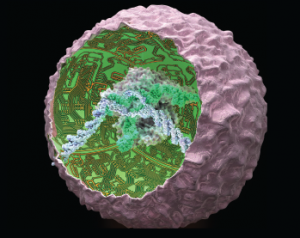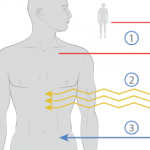
Smart cells were created by genetically reprogramming induced pluripotent stem cells using the CRISPR/Cas9 system to produce biologic drugs in an autoregulated manner.
Ella Marushchenko
The words genetically modified are making people run for the hills these days. Not so when it comes to arthritis care, however.
In the lab of one pioneering researcher, genetic engineering is catapulting arthritis treatment years ahead. Farshid Guilak, PhD, is a professor in the Department of Orthopaedic Surgery at Washington University, St. Louis, and director of research for the Shriners Hospitals for Children in St. Louis. He and his colleagues set out to find a solution to the problem that typically arises with arthritis drugs that attack the inflammation-promoting molecule tumor necrosis factor-alpha (TNFa): too broad an impact.
Dr. Guilak says, “Although current arthritis medications have shown some effectiveness in relieving pain and inflammation, these drugs are delivered system wide instead of being targeted to the affected joints. This creates more problems for patients because their immune systems are left vulnerable to infection. Our goal was to actually edit the genes such that the cells themselves would produce an anti-inflammatory drug.”
Working with colleagues at Duke University and Cytex Therapeutics Inc., they did just that.
Regenerative Approach to Arthritis

Farshid Guilak, PhD
Dr. Guilak, co-director of the Washington University Center of Regenerative Medicine, is co-senior author on the recently published work, “Genome Engineering of Stem Cells for Autonomously Regulated, Closed-Loop Delivery of Biologic Drugs.”1 He explains, “We first took skin cells from the tails of mice and transformed them into pluripotent stem cells, with the eventual goal of creating SMART (Stem Cells Modified for Autonomous Regenerative Therapy) cells.”
Jonathan M. Brunger, PhD, formerly with Duke University, is the paper’s first author. Now a postdoctoral fellow in cellular and molecular pharmacology at the University of California, San Francisco, Dr. Brunger says, “We took advantage of molecular tools that allowed us to rewire how cells respond to input from their environment. In this case, we used the genome engineering tool CRISPR (clustered regularly interspaced short palindromic repeats)/Cas9 to recode how a cell behaves in the context of inflammation.”
Repurposing Inflammatory Pathways
Dr. Guilak, who also has faculty appointments in the Departments of Developmental Biology and Biomedical Engineering at Washington University, elaborates on their process. “When TNF binds to receptors on the cell surface, it stimulates the production of an inflammatory response. We used CRISPR/Cas9 to directly target and inactivate an inflammatory gene, and then insert a gene that releases an anti-inflammatory biologic drug. When the rewired SMART cell encounters TNF, it triggers the production of the drug that blocks TNF. Because the cells are stem cells, we can then convert them to any other cell type, such as cartilage-producing cells—chondrocytes—that can repair damaged joints. This all means that arthritic cartilage is replaced and that joints and other tissues are protected.”
And this cell is so smart that it knows when to stop.
Tunable Cells with a 6th Sense
“Not only are these cells adjustable to the level of inflammation in the environment, but they know when to cut off production,” explains Dr. Guilak.
The scientists tested the cells’ responsiveness across three orders of magnitude of TNF concentrations. Each concentration elicited the intended response—rapid, feedback-controlled inhibition of TNF.
Dr. Guilak notes, “Once the TNF has been blocked, the cell automatically stops making the therapeutic drug, because it is the presence and severity of inflammation that drives the production of the TNF inhibitor by these cells. Thus, the cells act in an autonomous manner to tune the expression of the therapeutic drug in proportion to the amount of TNF present, even at very high concentrations.”
“In addition, we found that these effects held, even with high concentrations of TNF. “We also showed that other pro-inflammatory cytokines, such as interleukin 1, can be rapidly antagonized with a similar, cell-autonomous strategy. Our hope is that using a targeted, feedback-controlled system, such as this, will minimize the side effects that can occur with biologic drugs, such as TNF inhibitors, because they are currently given continuously at high doses.”
Next Steps

Jonathan Brunger, PhD
As for the most exciting near-term regenerative medicine opportunities that this work may lead to, Dr. Brunger says, “To be able to hijack cellular machinery to execute programmed, therapeutic responses and then engineer living tissue replacements from these ‘designer cells’ really opens up novel approaches, not only for the treatment of a variety of rheumatologic conditions, but for other chronic diseases as well—diabetes and Crohn’s disease, for example. This approach can also be used to enhance other cell therapies where feedback control is critical, such as cancer immunotherapy.
“Recent studies have shown that certain biomarkers for rheumatoid arthritis may precede the development of symptoms. Because early treatment can reduce the chance of joint damage and disability, a cell-based vaccine may be able to provide a means of stopping arthritis and other autoimmune diseases when the first signs of disease are detected.”
This work follows recent studies by Dr. Guilak’s group where they were able to grow an entire cartilage hip joint surface in the lab using stem cells and a biomaterial scaffold.
As for their next steps, Dr. Guilak states, “We are now testing these cells in several different mouse models of arthritis to ensure their safety and efficacy. An important step will be to determine the best way to deliver these cells systemically or directly to the joint so they provide the maximum beneficial effect. Our early studies look very promising in this respect. If things go as planned, we may be able to start human safety trials within several years.”
These “designer” cells, says Dr. Guilak, point to a future vaccine. “With this research, we have laid the groundwork for a cell-based vaccine that can be used to treat a diverse array of autoimmune or inflammatory diseases. The sky is the limit.”
Elizabeth Hofheinz, MPH, MEd, is a freelance medical editor and writer based in the Greater New Orleans area.
Contributors’ note: This work was supported by The Arthritis Foundation, the Nancy Taylor Foundation for Chronic Diseases, Shriners Hospitals for Children, the National Institutes of Health and the AO Foundation.
Reference
- Brunger JM, Zutshi A, Willard VP, et al. Genome engineering of stem cells for autonomously regulated, closed-loop delivery of biologic drugs challenges and opportunities. Stem Cell Reports. 2017 May 9;8(5):1202–1213.


